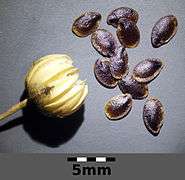Linum alpinum
Linum alpinum is a species of perennial plant belonging to the Linaceae family.
| Linum alpinum | |
|---|---|
.jpg) | |
| Flowers of Linum alpinum subsp. alpinum | |
| Scientific classification | |
| Kingdom: | Plantae |
| Clade: | Tracheophytes |
| Clade: | Angiosperms |
| Clade: | Eudicots |
| Clade: | Rosids |
| Order: | Malpighiales |
| Family: | Linaceae |
| Genus: | Linum |
| Species: | L. alpinum |
| Binomial name | |
| Linum alpinum Jacq., 1762 | |
| Synonyms | |
| |
Etymology
The Latin genus name Linum means thread, where as the species name alpinum means from the Alps.
Subspecies
Subspecies include:[1]
- Linum alpinum subsp. alpinum Jacq., 1762
- Linum alpinum subsp. bertolonii Guarino & Pignatti
- Linum alpinum subsp. collinum (Guss. ex Boiss.) J.-M.Tison
- Linum alpinum subsp. gracilius (Bertol.) Pignatti
- Linum alpinum subsp. julicum (Hayek) Hegi
- Linum alpinum subsp. laeve (Scop.) Nyman
- Linum alpinum subsp. pirinicum A. Petrova
Distribution and habitat
This orophyte species occurs in central and southern Europe and western Asia, in rocky lawns, limestone hills and mountains of Pyrenees, Alps, Apennines, Rhodope Mountains and Urals, at an elevation of 1,400–2,500 m (4,600–8,200 ft) above sea level.[2]
Description
Linum alpinum has stems erect or recumbent, densely leafed, reaching an average of 10–50 cm (3.9–19.7 in) in height. This plant is glabrous and woody at the base. It has alternate leaves that are linear-lanceolate, up to 2.5 cm (0.98 in) long, and sessile. The hermaphrodite, rather large flowers with radial symmetry are blue, yellow at the bottom, with a diameter of 2–3 cm (0.79–1.18 in) and with erect or slightly inclined pedicels, in loose clusters each containing one to eight flowers. Sepals are unequal, with three veins at the base, 5-7 mm long. The petals are 12-20 mm long, three-four times longer than sepals. The fruits are capsules 6-8 mm long. Each fruit compartment contains a blackish seed.[2][3] This species is quite similar to Linum leonii and Linum ockendonii.[4]
Biology
This perennial plant blooms from May to August.[2] The flowers are bent before flowering, where as floral peduncles remain erect after flowering. Typical pollinators are insects (bees, bumblebees, wasps, hoverflies, etc.).
Gallery
- Plant of Linum alpinum
- Close-up on a flower of Linum alpinum subsp. julicum
 Fruit with seeds
Fruit with seeds_(6312027130).jpg) Illustration from Atlas der Alpenflora (1882)
Illustration from Atlas der Alpenflora (1882)
External links
References
| Wikimedia Commons has media related to Linum alpinum. |
- of life
- Tela Botanica (in French)
- Pignatti S. - Flora d'Italia – Edagricole – 1982. Vol. II, pag. 20 (in Italian)
- Info Flora (in German)
- Conti F., Abbate G., Alessandrini A., Blasi C., 2005 - An annotated checklist of the Italian vascular flora - Palombi Editori